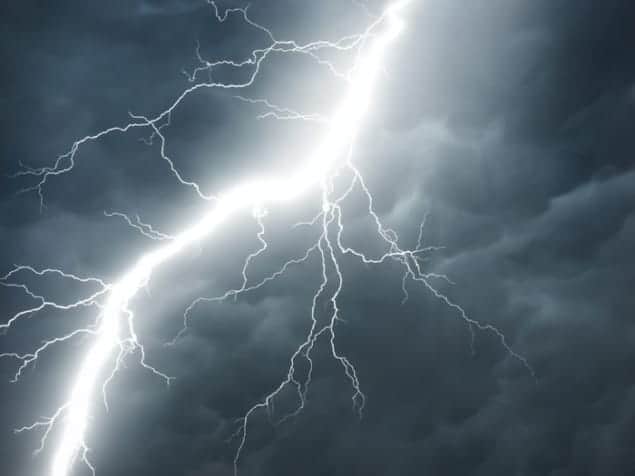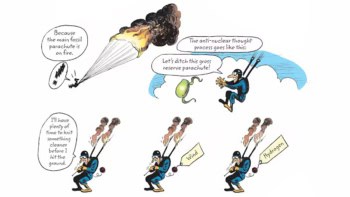
Researchers in China are the first to study ball lightning using high-resolution spectroscopy. Their results lend support to an idea first advanced in 2000 that ball lightning is fuelled by burning minerals from soil.
Ball lightning is one of the strangest phenomena in atmospheric physics, with reports of glowing spheres or ellipsoids chasing cows, flying through windows or appearing in aeroplanes. While a growing amount of evidence points to its existence, ball lightning has never been properly explained. This is because its rarity and unpredictability make systematic field study impossible.
Indeed, accounts of ball lightning can vary dramatically. Most have the orb moving horizontally just above the ground at speeds of several metres per second, but others have described balls that move either up or down. The motion can be along either straight or meandering paths; the balls seem to vary in size between 1–100 cm; they endure for about 1–10 s before vanishing; and their colour can be white, orange, yellow, purple or green.
Reduction and oxidation
In 2000 John Abrahamson and James Dinniss of the University of Canterbury in New Zealand suggested that ball lightning is caused by lightning striking silicon-rich soil. If the earth gets hot enough to be vaporized, carbon from the soil reduces silicon from silica to its elemental form. In the oxygen-rich environment of the air, however, it rapidly oxidizes once more, emitting black-body radiation that we perceive as ball lightning.
Then in 2006, Eli Jerby and Vladimir Dikhtyar at Tel Aviv University produced some evidence to support this theory. They created levitating fireballs by irradiating solid materials such as silicon with high-power microwaves that melted and then vaporized material from the surface. However, there was no direct evidence that actual ball lightning occurs in this way.
Lucky strike
Then in 2012, Jianyong Cen, Ping Yuan and Simin Xue from Northwest Normal University in China had a stroke of luck. The team was recording thunderstorms in the country’s Qinghai Plateau with high-speed cameras with high spectral resolution in an attempt to determine the spectral characteristics of ordinary lightning. By pure chance, one of the lightning strikes that the researchers recorded was followed by the appearance of a glowing sphere about 5 m in size, moving at about 8.6 m s–1 and lasting just beyond 1.5 s. It started out a bright purple-white colour before gradually turning orange, white and finally red.
The entire event was captured on a digital video camera. The latter half was also recorded on a high-speed camera that records 3000 frames per second, but which unfortunately cannot operate continuously – the initial strike occurred during the instrument’s “off” phase.
Analysing the pictures taken, the researchers found clear emission lines from silicon, iron and calcium – the main components of soil. The researchers say this supports the idea that the energy source for ball lightning is a burning core of soil. Curiously, however, there was also an intensity fluctuation at about 100 Hz. The event occurred near some high-voltage power lines with a frequency of 50 Hz, and the authors suggest this intensity modulation could be related to this proximity.
Model development
Jerby told physicsworld.com that the spectroscopy result is a significant development. He believes that the atypically large size of the ball and the mysterious 100 Hz intensity fluctuation prevent the event being labelled ball lightning with certainty, although he believes it is “very likely”. Assuming this is the case, he says that “the optical and spectral characteristics reported in this paper are of great importance, as they provide significant experimental data for the development of more comprehensive ball-lightning models.”
Abrahamson agrees that the observed phenomenon is very likely to have been ball lightning, and believes the researchers “have done a good job and made the best of the opportunity that their unexpected observation gave them”. He added that, to his knowledge, “no other observer has been able to measure the optical spectra of ball lighting, let alone find the changes of this during its lifetime”. He is especially intrigued by the observation that the emission lines of nitrogen and oxygen oscillate rapidly with time, whereas those of silicon, iron and calcium change only slowly. “This argues for two different sources of radiance from the same ball,” he says.
The research will be published in a forthcoming issue of Physical Review Letters.



